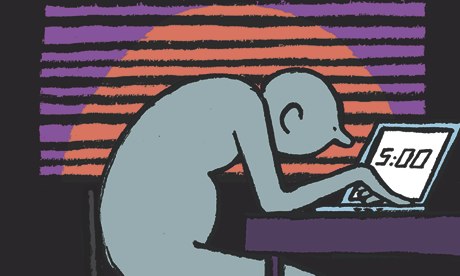What are the benefits of being a Hindu?
Kerala actor Joy Mathew has kicked up a debate on social media about the differences between Hinduism and Abrahamic religions. The post has gone viral since then.
“Benefits of being Hindu- No need to go and learn religion in childhood. No restrictions about what to do or what not to do. No hard and fast rules about how to live your life,” began the Facebook post of Mathew, who is known as a ‘political actor’ in Kerala.
Mathew, however, has confessed that it is not a post written by him. “One of my friends sent this to me on WhatsApp. I am posting it here for my readers since I find elements of truth in it,” he said, adding, “I am not a slave to any religion."
The one-liners in his post say, in Hinduism, "there is no need to wear a cap, no need of circumcision, no baptism."
“There is no compulsion to go to temples. Only believers have to go. If you wish to go, you can go to any temple irrespective of the caste, language or the ritualistic traditions.
You won’t be labeled agnostic. You won’t be excommunicated.
At the time of marriage, you won’t need a character certificate from the priests. Bride’s family won’t go to the temples to check if you practise religion.”
You can live your life peacefully with only one or two children as you like.
Since there is no restriction to drink, you don’t need to spoil your life by getting addict to weed and drugs.
You can watch films. You can dance. You can sing. You can give and take money for interest.
You can live your life as you like. There are no doctrines.
There are no scary stories about the life after death.
You don’t need to spoil your life dreaming about rivers of wine and houries in heaven.
You don’t need to fear about becoming the firewood in the hell.
There is nothing that goes against the modern science.
There are no special rules for women. No one will abuse if a woman dances. Instead, they will clap and encourage. They will even send girls for dance classes. And for sports too. You don’t need to cover your face, nor head. You can wear the dresses of your choice. Women can eat along with men.
You can worship any god of any religion. You can light stars. You can make cribs. You can celebrate any festival. You can wish your friends on any festival.
Also, you can share this post without fear” he concludes.
'People will forgive you for being wrong, but they will never forgive you for being right - especially if events prove you right while proving them wrong.' Thomas Sowell
Search This Blog
Showing posts with label ritual. Show all posts
Showing posts with label ritual. Show all posts
Thursday, 18 March 2021
Monday, 22 October 2018
The pilgrimage’s progress
Janaki Nair in The Hindu

Shortcuts and compromises
In the 1960s, the young ‘Ayyappa’ would have been among the 15,000 or so who made that arduous journey. No longer. In the past five decades, as the numbers have burgeoned to millions, Lord Ayyappa has been witness to, and extremely tolerant of, every aspect of the pilgrimage being changed beyond recognition. Let us begin with the most important reason being cited for prohibiting women pilgrims of menstruating age: that they cannot maintain the 41-day vratham. Yet, as we know from personal knowledge, and from detailed anthropological studies of this pilgrimage, the shortcuts and compromises on that earlier observance have been many and Lord Ayyappa himself seems to have taken the changes in his stride.
Not all those who reach the foot of the 18 steps that have to be mounted for the darshan of the celibate god observe all aspects of the vratham. A corporate employee, such as one in my family, may observe the restrictions on meat, alcohol and sex, but has given up the compulsion of wearing black or being barefoot. I recall being startled when I saw ‘Ayyappas’ clad in black enjoying a smoke in the corner of the newspaper office where I once worked; I was told that it was only alcohol that was to be abjured. My surprise was greater when I saw several relatives donning the mala about a week before setting off on the pilgrimage, a serious abbreviation of the 41-day temporary asceticism. Though this has meant no diminution in the faith of those visiting the shrine, clearly the pilgrim’s progress has been adapted to the temporalities of modern life.
Lord Ayyappa has surely observed that the longer pedestrian route to his forest shrine has been shortened by the bus route. From 1,29,000 private vehicles in 2000 to 2,65,000 in 2005, not to mention the countless bus trips, this has resulted in intolerable strains on a fragile ecology. In other words, pilgrim tourism, far from being promoted by women’s entry to Sabarimala, had already reached unbearable limits.
One of the most vital practices of this pilgrimage enjoins the pilgrim to carry his own consumption basket: nothing should be available for purchase. Provisions for drinking and cleaning water apart, the sacred geography of the shrine was preserved by such restrictions on consumption. But like many large religious corporations such as Tirumala Tirupati Devasthanams, the conveniences of commerce have pervaded every step of the way, with shops selling ‘Ayyapan Bags’ and other ‘ladies’ items’ that can be carried back to the women in the family. In addition to the gilding of the 18 steps, which naturally disallows the quintessential ritual of breaking coconuts, Lord Ayyappa may perhaps have been somewhat amused by the conveyor belt that carries the offerings to be counted. Those devotees who take a ‘return route’ home via Kovalam to relieve the severities of the temporary celibacy would perhaps be pardoned, even by the Lord, as much as by anthropologists who have noted such interesting accretions. And in 2016, according to the Quarterly Current Affairs, the Modi government announced plans to make Sabarimala an International Pilgrim Centre (as opposed to the State government’s request to make it a National Pilgrim Centre) for which funds “would never be a problem”.
The invention of ‘tradition’
Lest this be mistaken for a cynical recounting of the countless ways in which the pilgrimage has been ‘corrupted’, let me hasten to say that my point is far simpler. Anyone who studies the social life and history of religion will recognise that practices are constantly adapted and reshaped, as collectivities themselves are changed, adapted and refashioned to suit the constraints of cash, time or even aesthetics. For this, the historians E.J. Hobsbawm and Terence Ranger coined the term “the invention of tradition”. Who amongst us does not, albeit with a twinge of guilt, agree to the ‘token’ clipping of the hair at Tirupati in lieu of the full head shave? Who does not feel an unmatched pleasure in the piped water that gently washes the feet as we turn the corner into the main courtyard of Tirupati after hours of waiting in hot and dusty halls? And who does not feel frustrated at the not-so-gentle prod of the wooden stick by the guardian who does not allow you more than a few seconds before the deity at Guruvayur? All these belong properly to the invention of ‘tradition’ leaving no practice untouched by the conveniences of mass management.
But perhaps the most important invention of ‘tradition’ was the absolute prohibition of women of menstruating age from worship at Sabarimala under rules 3(b) framed under the Kerala Hindu Places of Public Worship (Authorisation of Entry) Act, 1965. Personal testimonies have shown that strict prohibition was not, in fact, always observed, but would such a legal specification have been necessary at all if everyone was abiding by that usage or custom from ‘time immemorial’? It is a “custom with some aberrations” as pointed out by Indira Jaisingh, citing the Devaswom Board’s earlier admission that women had freely entered the shrine before 1950 for the first rice feeding ceremonies of their children.
Elsewhere, the celibate Kumaraswami, in Sandur in Karnataka where women were strictly disallowed, has gracefully conceded space to women worshippers since 1996. “The heavens have not fallen,” Gandhi remarked in 1934 when “a small state in south India [Sandur] has opened the temple to the Harijans.” Lord Ayyappa, who has tolerated innumerable changes in the behaviour of his devotees, will surely not allow his wrath to manifest itself. He will be saddened by the hypermobilisation that surrounds the protests today, but would be far more forgiving than the men — and those women — who make, unmake and remake the rules of worship.
The rules of worship are made, unmade, and remade over time and Sabarimala is no exception
I remember seeing the ‘birth’ of Ayyappa on stage during a Kathakali performance. Following the drama of Bhasmasura’s destruction by Vishnu as Mohini, Shiva’s fear turning to gratitude, the two ‘male’ gods retreated behind the curtain drawn across the stage. The curtain trembled to the clash and roar of cymbals, drums and singing, before being lowered to reveal an image of Ayyappa. We were overawed by the performance and did not think of raising questions about the ways of the gods. I remember too, in the late 1960s, participating in the ‘kettanara’ rituals (the placing of the bundle of offerings and some items for sustenance on the pilgrim’s head before he sets off on the pilgrimage) of young cousins departing for Sabarimala on foot. The ritual involved all the women in the household. The young men were unshaven, in black, had donned the mala, and were ready to walk the long route barefoot after having observed their 41-day vrathams. I was overawed by the faith of the young ‘Ayyappa’, the women, and was too young to raise any ‘why nots’.
I remember seeing the ‘birth’ of Ayyappa on stage during a Kathakali performance. Following the drama of Bhasmasura’s destruction by Vishnu as Mohini, Shiva’s fear turning to gratitude, the two ‘male’ gods retreated behind the curtain drawn across the stage. The curtain trembled to the clash and roar of cymbals, drums and singing, before being lowered to reveal an image of Ayyappa. We were overawed by the performance and did not think of raising questions about the ways of the gods. I remember too, in the late 1960s, participating in the ‘kettanara’ rituals (the placing of the bundle of offerings and some items for sustenance on the pilgrim’s head before he sets off on the pilgrimage) of young cousins departing for Sabarimala on foot. The ritual involved all the women in the household. The young men were unshaven, in black, had donned the mala, and were ready to walk the long route barefoot after having observed their 41-day vrathams. I was overawed by the faith of the young ‘Ayyappa’, the women, and was too young to raise any ‘why nots’.
Shortcuts and compromises
In the 1960s, the young ‘Ayyappa’ would have been among the 15,000 or so who made that arduous journey. No longer. In the past five decades, as the numbers have burgeoned to millions, Lord Ayyappa has been witness to, and extremely tolerant of, every aspect of the pilgrimage being changed beyond recognition. Let us begin with the most important reason being cited for prohibiting women pilgrims of menstruating age: that they cannot maintain the 41-day vratham. Yet, as we know from personal knowledge, and from detailed anthropological studies of this pilgrimage, the shortcuts and compromises on that earlier observance have been many and Lord Ayyappa himself seems to have taken the changes in his stride.
Not all those who reach the foot of the 18 steps that have to be mounted for the darshan of the celibate god observe all aspects of the vratham. A corporate employee, such as one in my family, may observe the restrictions on meat, alcohol and sex, but has given up the compulsion of wearing black or being barefoot. I recall being startled when I saw ‘Ayyappas’ clad in black enjoying a smoke in the corner of the newspaper office where I once worked; I was told that it was only alcohol that was to be abjured. My surprise was greater when I saw several relatives donning the mala about a week before setting off on the pilgrimage, a serious abbreviation of the 41-day temporary asceticism. Though this has meant no diminution in the faith of those visiting the shrine, clearly the pilgrim’s progress has been adapted to the temporalities of modern life.
Lord Ayyappa has surely observed that the longer pedestrian route to his forest shrine has been shortened by the bus route. From 1,29,000 private vehicles in 2000 to 2,65,000 in 2005, not to mention the countless bus trips, this has resulted in intolerable strains on a fragile ecology. In other words, pilgrim tourism, far from being promoted by women’s entry to Sabarimala, had already reached unbearable limits.
One of the most vital practices of this pilgrimage enjoins the pilgrim to carry his own consumption basket: nothing should be available for purchase. Provisions for drinking and cleaning water apart, the sacred geography of the shrine was preserved by such restrictions on consumption. But like many large religious corporations such as Tirumala Tirupati Devasthanams, the conveniences of commerce have pervaded every step of the way, with shops selling ‘Ayyapan Bags’ and other ‘ladies’ items’ that can be carried back to the women in the family. In addition to the gilding of the 18 steps, which naturally disallows the quintessential ritual of breaking coconuts, Lord Ayyappa may perhaps have been somewhat amused by the conveyor belt that carries the offerings to be counted. Those devotees who take a ‘return route’ home via Kovalam to relieve the severities of the temporary celibacy would perhaps be pardoned, even by the Lord, as much as by anthropologists who have noted such interesting accretions. And in 2016, according to the Quarterly Current Affairs, the Modi government announced plans to make Sabarimala an International Pilgrim Centre (as opposed to the State government’s request to make it a National Pilgrim Centre) for which funds “would never be a problem”.
The invention of ‘tradition’
Lest this be mistaken for a cynical recounting of the countless ways in which the pilgrimage has been ‘corrupted’, let me hasten to say that my point is far simpler. Anyone who studies the social life and history of religion will recognise that practices are constantly adapted and reshaped, as collectivities themselves are changed, adapted and refashioned to suit the constraints of cash, time or even aesthetics. For this, the historians E.J. Hobsbawm and Terence Ranger coined the term “the invention of tradition”. Who amongst us does not, albeit with a twinge of guilt, agree to the ‘token’ clipping of the hair at Tirupati in lieu of the full head shave? Who does not feel an unmatched pleasure in the piped water that gently washes the feet as we turn the corner into the main courtyard of Tirupati after hours of waiting in hot and dusty halls? And who does not feel frustrated at the not-so-gentle prod of the wooden stick by the guardian who does not allow you more than a few seconds before the deity at Guruvayur? All these belong properly to the invention of ‘tradition’ leaving no practice untouched by the conveniences of mass management.
But perhaps the most important invention of ‘tradition’ was the absolute prohibition of women of menstruating age from worship at Sabarimala under rules 3(b) framed under the Kerala Hindu Places of Public Worship (Authorisation of Entry) Act, 1965. Personal testimonies have shown that strict prohibition was not, in fact, always observed, but would such a legal specification have been necessary at all if everyone was abiding by that usage or custom from ‘time immemorial’? It is a “custom with some aberrations” as pointed out by Indira Jaisingh, citing the Devaswom Board’s earlier admission that women had freely entered the shrine before 1950 for the first rice feeding ceremonies of their children.
Elsewhere, the celibate Kumaraswami, in Sandur in Karnataka where women were strictly disallowed, has gracefully conceded space to women worshippers since 1996. “The heavens have not fallen,” Gandhi remarked in 1934 when “a small state in south India [Sandur] has opened the temple to the Harijans.” Lord Ayyappa, who has tolerated innumerable changes in the behaviour of his devotees, will surely not allow his wrath to manifest itself. He will be saddened by the hypermobilisation that surrounds the protests today, but would be far more forgiving than the men — and those women — who make, unmake and remake the rules of worship.
Sunday, 5 August 2018
The empty rituals of daily lives
Tabish Khair in The Hindu

Just as religious rituals move the practitioner away from the immensity of faith, secular rituals move citizens’ attention away from real issues
Serious religious thinkers have tended to distinguish between ritual and religion. Some, of course, have distinguished between spirituality and religion too, mostly because they have associated religion with rituals.
Now, rituals have their uses, as long as we employ them in the full awareness that they are arbitrary and man-made. This applies to secular matters as well as religious ones: I like my ritual of a morning cup of coffee with a biscuit or two, but I do not assume that this is god-ordained or that my day will not commence unless I have my cup of coffee. So, I am not talking of rituals of this sort. I am talking of rituals that are made ‘essential’ to either religion or secular life.
The matter with religion is clear enough. The reason why religious but nonconforming thinkers, like Kabir, railed against rituals was that they perceived how rituals are used, in the name of religion, to control, influence and exploit people. They also felt that rituals are worldly matters and have nothing to do with the divine. The priestly classes insist on rituals, as if god would care about the colour of your dress, the posture of your prayer, the number of your beads, etc. Rituals proliferate in religions because they allow the priestly classes to control and exploit ordinary believers. Instead of being used as an option, the coffee cup ritual becomes a necessity imposed on the ordinary believer, often at great cost.
Rituals in secular life
This much is clear enough about religion, and explains why so many religious thinkers — apart from the accredited priestly classes, whether mullahs or pandits — tended to criticise rituals or blind observance of rituals. But how, you might be asking, do rituals work in the secular sphere? Because such rituals are not confined to religion. They also exist in secular life, and are used by various ‘priestly classes’ to mislead, control and exploit ordinary people. I suspect that basically religious people, conditioned to associate belief with rituals, are likely to be misled by rituals in secular life too.
A ritual in secular life is like a ritual in religion: it is demanding, obsessive, unavoidable, essential. It is the one thing that you ‘need’ to do in order to have a good life (in this world or the next, or both). Or so the priestly classes claim. Because when you really look at this ‘essential’ ritual, it falls apart. It is not necessary; you can do without it. You can understand the world in other ways, live your life differently. But no, the priestly classes claim, you have to practice this ritual — or you will suffer and probably be damned for all eternity!
Rituals of prosperity
Think of the rituals that we are surrounded by in ordinary secular life. Think, for instance, of all those economic figures trotted out by national economists in all countries to show that the nation is progressing. GNP. Average national income. The rising value of shares in the stock market. These are rituals of prosperity, because if you really look into them, they mean nothing. Or they mean nothing because they have been turned from actual, though limited, indicators into sweeping rituals: empty practices.
A rise in GNP, the average national income, or the share market can indicate some types of prosperity, but these are not enough — and they are misleading when trotted out in ritualistic fashion by politicians. In each case, there is a good chance that some people might be gaining and many more losing. Take the situation of Amazon: the company is thriving, but, at least in the U.S., it is reputed to offer its workers a very meagre wage package and unsatisfactory working conditions. To think that the profits being made by Amazon is percolating down to its workers is to make a mistake. But that is the mistake we make when we simply note the net value of Amazon or the rise in its shares. Such figures play the role of empty rituals.
With countries, the matter is even more complex, as the prosperity of a country depends on factors other than financial ones. Hence, politicians who give us general figures and averages, whether correct or not, are indulging in empty rituals.
Of course, figures are not the only rituals practiced by politicians in power, the apex of the secular priestly classes. For instance, it is a ritual to construct a highway without making a sustained effort to improve the existing highways, to create a super-city without a sustained effort to improve the urban infrastructure in existing cities, to raise the statue of a great leader and ignore the best aspects of his example.
These acts and decisions are rituals because they are empty and misleading. Just as a ritual in religion moves the practitioner away from the endless immensity of faith to a delusive shortcut, a ritual in secular life moves citizens’ attention away from all the real issues and offers a soupçon of misleading satisfaction. I fear that we Indians might or might not be a spiritual people, but we do have a certain tendency to indulge — and let others indulge — in empty rituals in religious as well as secular life.
Serious religious thinkers have tended to distinguish between ritual and religion. Some, of course, have distinguished between spirituality and religion too, mostly because they have associated religion with rituals.
Now, rituals have their uses, as long as we employ them in the full awareness that they are arbitrary and man-made. This applies to secular matters as well as religious ones: I like my ritual of a morning cup of coffee with a biscuit or two, but I do not assume that this is god-ordained or that my day will not commence unless I have my cup of coffee. So, I am not talking of rituals of this sort. I am talking of rituals that are made ‘essential’ to either religion or secular life.
The matter with religion is clear enough. The reason why religious but nonconforming thinkers, like Kabir, railed against rituals was that they perceived how rituals are used, in the name of religion, to control, influence and exploit people. They also felt that rituals are worldly matters and have nothing to do with the divine. The priestly classes insist on rituals, as if god would care about the colour of your dress, the posture of your prayer, the number of your beads, etc. Rituals proliferate in religions because they allow the priestly classes to control and exploit ordinary believers. Instead of being used as an option, the coffee cup ritual becomes a necessity imposed on the ordinary believer, often at great cost.
Rituals in secular life
This much is clear enough about religion, and explains why so many religious thinkers — apart from the accredited priestly classes, whether mullahs or pandits — tended to criticise rituals or blind observance of rituals. But how, you might be asking, do rituals work in the secular sphere? Because such rituals are not confined to religion. They also exist in secular life, and are used by various ‘priestly classes’ to mislead, control and exploit ordinary people. I suspect that basically religious people, conditioned to associate belief with rituals, are likely to be misled by rituals in secular life too.
A ritual in secular life is like a ritual in religion: it is demanding, obsessive, unavoidable, essential. It is the one thing that you ‘need’ to do in order to have a good life (in this world or the next, or both). Or so the priestly classes claim. Because when you really look at this ‘essential’ ritual, it falls apart. It is not necessary; you can do without it. You can understand the world in other ways, live your life differently. But no, the priestly classes claim, you have to practice this ritual — or you will suffer and probably be damned for all eternity!
Rituals of prosperity
Think of the rituals that we are surrounded by in ordinary secular life. Think, for instance, of all those economic figures trotted out by national economists in all countries to show that the nation is progressing. GNP. Average national income. The rising value of shares in the stock market. These are rituals of prosperity, because if you really look into them, they mean nothing. Or they mean nothing because they have been turned from actual, though limited, indicators into sweeping rituals: empty practices.
A rise in GNP, the average national income, or the share market can indicate some types of prosperity, but these are not enough — and they are misleading when trotted out in ritualistic fashion by politicians. In each case, there is a good chance that some people might be gaining and many more losing. Take the situation of Amazon: the company is thriving, but, at least in the U.S., it is reputed to offer its workers a very meagre wage package and unsatisfactory working conditions. To think that the profits being made by Amazon is percolating down to its workers is to make a mistake. But that is the mistake we make when we simply note the net value of Amazon or the rise in its shares. Such figures play the role of empty rituals.
With countries, the matter is even more complex, as the prosperity of a country depends on factors other than financial ones. Hence, politicians who give us general figures and averages, whether correct or not, are indulging in empty rituals.
Of course, figures are not the only rituals practiced by politicians in power, the apex of the secular priestly classes. For instance, it is a ritual to construct a highway without making a sustained effort to improve the existing highways, to create a super-city without a sustained effort to improve the urban infrastructure in existing cities, to raise the statue of a great leader and ignore the best aspects of his example.
These acts and decisions are rituals because they are empty and misleading. Just as a ritual in religion moves the practitioner away from the endless immensity of faith to a delusive shortcut, a ritual in secular life moves citizens’ attention away from all the real issues and offers a soupçon of misleading satisfaction. I fear that we Indians might or might not be a spiritual people, but we do have a certain tendency to indulge — and let others indulge — in empty rituals in religious as well as secular life.
Sunday, 13 March 2016
Are we ready to confront death without religion?
A rise in atheist funerals shows that fewer of us need to rely on faith when confronted with mortality
Adam Lee in The Guardian
For centuries, the Christian church wrote the script for how westerners deal with death. There was the deathbed confession, the last rites, the pallbearers, the obligatory altar call, the burial ceremony, the stone, the angels-and-harps imagery. Yet that archaic and stereotypical vision of death, like a mossy and weather-worn statue, is crumbling – and in its place, something new and better has a chance to grow.
Traditional funerals and burials are declining in popularity (to the point where churches are bemoaning the trend), in favor of alternatives like green burial and cremation. Personalized humanist funerals and secular celebrants are becoming more common, echoing a trend that’s also occurring with weddings.
As younger generations turn away from religion, the US is slowly but surely becoming more secular. As mortician and “good death” advocate Caitlin Doughty writes in her book, Smoke Gets In Your Eyes & Other Lessons from the Crematory, America is seeing a sea-change in traditions and rituals surrounding mortality.
Doughty and others see this shift not as something to be lamented, but to be embraced. Instead of following a script that’s been written for us, we can create our own customs and choose for ourselves how we want to be remembered. We can design funerals that emphasize the good we did, the moments that made our lives meaningful and the lessons we’d like to pass on.
Rather than the same handful of biblical passages, we can have readings from any book, poem or song in the whole broad tapestry of human culture. Rather than mourning, gloom and sermons on sin, we can have ceremonies that are joyful celebrations of the deceased person’s life.
But the rise of humanism isn’t just influencing what funerals look like; it’s changing how we die. For ages, when the church’s word was law, suicide was deemed a mortal sin. Even today, studies find that more fervent religious devotion correlates to more desire for aggressive and medically futile end-of-life intervention, not less.
The most famous case in recent years was Brittany Maynard, a 29-year-old woman with terminal brain cancer who ended her life in 2014 under Oregon’s death-with-dignity law. Maynard’s story put a sympathetic public face on the right-to-die movement, which proved decisive when California Governor Jerry Brown, a former Jesuit seminarian, signed a similar bill the next year despite heavy pressure from religious groups. He, too, cited the value of autonomy and freedom from suffering:
“In the end, I was left to reflect on what I would want in the face of my own death,” Brown wrote in a signing message. “I do not know what I would do if I were dying in prolonged and excruciating pain” he added.
In California and elsewhere, the staunchest adversaries of the right to die are churches and religious believers who assert that the time, place and manner of each person’s death is chosen by God, and that we have no right to change that regardless of the human cost.
And yet, almost without notice, that’s become a minority position. Gallup polls now find that as many as 70% of Americans now support a right to aid in dying. This position entails that, when people are suffering without hope of recovery, they should be allowed to end their lives painlessly, with medical help, at a time of their choosing.
This, too, is a deeply humanist conception of death. It springs from the idea that needless suffering is the greatest evil there is and that autonomy is the supreme value. If we’re the ultimate owners of our own lives, then we have the right to lay them down when we judge they’ve become unbearable.
Even as religious trappings linger in our rituals and attitudes around death, society is coming to adopt the humanist viewpoint on mortality, neither fearing nor denying it, but gracefully accepting it as an inevitable part of the human experience. The sooner we bury our religious past, the better.
Adam Lee in The Guardian
For centuries, the Christian church wrote the script for how westerners deal with death. There was the deathbed confession, the last rites, the pallbearers, the obligatory altar call, the burial ceremony, the stone, the angels-and-harps imagery. Yet that archaic and stereotypical vision of death, like a mossy and weather-worn statue, is crumbling – and in its place, something new and better has a chance to grow.
Traditional funerals and burials are declining in popularity (to the point where churches are bemoaning the trend), in favor of alternatives like green burial and cremation. Personalized humanist funerals and secular celebrants are becoming more common, echoing a trend that’s also occurring with weddings.
As younger generations turn away from religion, the US is slowly but surely becoming more secular. As mortician and “good death” advocate Caitlin Doughty writes in her book, Smoke Gets In Your Eyes & Other Lessons from the Crematory, America is seeing a sea-change in traditions and rituals surrounding mortality.
Doughty and others see this shift not as something to be lamented, but to be embraced. Instead of following a script that’s been written for us, we can create our own customs and choose for ourselves how we want to be remembered. We can design funerals that emphasize the good we did, the moments that made our lives meaningful and the lessons we’d like to pass on.
Rather than the same handful of biblical passages, we can have readings from any book, poem or song in the whole broad tapestry of human culture. Rather than mourning, gloom and sermons on sin, we can have ceremonies that are joyful celebrations of the deceased person’s life.
But the rise of humanism isn’t just influencing what funerals look like; it’s changing how we die. For ages, when the church’s word was law, suicide was deemed a mortal sin. Even today, studies find that more fervent religious devotion correlates to more desire for aggressive and medically futile end-of-life intervention, not less.
The most famous case in recent years was Brittany Maynard, a 29-year-old woman with terminal brain cancer who ended her life in 2014 under Oregon’s death-with-dignity law. Maynard’s story put a sympathetic public face on the right-to-die movement, which proved decisive when California Governor Jerry Brown, a former Jesuit seminarian, signed a similar bill the next year despite heavy pressure from religious groups. He, too, cited the value of autonomy and freedom from suffering:
“In the end, I was left to reflect on what I would want in the face of my own death,” Brown wrote in a signing message. “I do not know what I would do if I were dying in prolonged and excruciating pain” he added.
In California and elsewhere, the staunchest adversaries of the right to die are churches and religious believers who assert that the time, place and manner of each person’s death is chosen by God, and that we have no right to change that regardless of the human cost.
And yet, almost without notice, that’s become a minority position. Gallup polls now find that as many as 70% of Americans now support a right to aid in dying. This position entails that, when people are suffering without hope of recovery, they should be allowed to end their lives painlessly, with medical help, at a time of their choosing.
This, too, is a deeply humanist conception of death. It springs from the idea that needless suffering is the greatest evil there is and that autonomy is the supreme value. If we’re the ultimate owners of our own lives, then we have the right to lay them down when we judge they’ve become unbearable.
Even as religious trappings linger in our rituals and attitudes around death, society is coming to adopt the humanist viewpoint on mortality, neither fearing nor denying it, but gracefully accepting it as an inevitable part of the human experience. The sooner we bury our religious past, the better.
Thursday, 3 July 2014
Rowan Williams: how Buddhism helps me pray
John Bingham in The Telegraph
The former Archbishop of Canterbury Lord Williams has disclosed that he spends up to 40 minutes a day squatting and repeating an Eastern Orthodox prayer while performing breathing exercises as part of a routine influenced by Buddhism.
He also spends time pacing slowly and repeatedly prostrating himself as part of an intense early morning ritual of silent meditation and prayer.
The normally private former Archbishop has given a glimpse of his personal devotions in an article for the New Statesman explaining the power of religious ritual in an increasingly secular world.
Lord Williams has spoken in the past about how in his youth he contemplated becoming a monk as well as joining the Orthodox church.
He explained that he draws daily inspiration from the practice, common to both the Greek and Russian orthodox churches, of meditating while repeatedly reciting the “Jesus Prayer”, which says: “Lord Jesus Christ, Son of God, have mercy upon me, a sinner”.
“Over the years increasing exposure to and engagement with the Buddhist world in particular has made me aware of practices not unlike the ‘Jesus Prayer’ and introduced me to disciplines that further enforce the stillness and physical focus that the prayer entails,” he explained
“Walking meditation, pacing very slowly and coordinating each step with an out-breath, is something I have found increasingly important as a preparation for a longer time of silence.
“So: the regular ritual to begin the day when I’m in the house is a matter of an early rise and a brief walking meditation or sometimes a few slow prostrations, before squatting for 30 or 40 minutes (a low stool to support the thighs and reduce the weight on the lower legs) with the 'Jesus Prayer': repeating (usually silently) the words as I breathe out, leaving a moment between repetitions to notice the beating of the heart, which will slow down steadily over the period.”
Far from it being like a “magical invocation”, he explained that the routine helps him detach himself from “distracted, wandering images and thoughts”, picturing the human body as like a 'cave' through which breath passes.
“If you want to speak theologically about it, it’s a time when you are aware of your body as simply a place where life happens and where, therefore, God ‘happens’: a life lived in you,” he added.
He went on to explain that those who perform such rituals regularly could reach "advanced states" and become aware of an "unbroken inner light".
Friday, 27 December 2013
Why Atheists need rituals too
To move many away from religion, atheism has to weave itself into the social fabric and shed its image of dour grumpiness

- Suzanne Moore for New Humanist, part of the Guardian Comment Network
- theguardian.com,

A billboard sponsored by the American Atheists organisation in New York. Photograph: Richard Levine/Demotix/Corbis
The last time I put my own atheism through the spin cycle rather than simply wiping it clean was when I wanted to make a ceremony after the birth of my third child. Would it be a blessing? From who? What does the common notion of a new baby as a gift mean? How would we make it meaningful to the people we invited who were from different faiths? And, importantly, what would it look like?
One of the problems I have with the New Atheism is that it fixates on ethics, ignoring aesthetics at its peril. It tends also towards atomisation, relying on abstracts such as "civic law" to conjure a collective experience. But I love ritual, because it is through ritual that we remake and strengthen our social bonds. As I write, down the road there is a memorial being held for Lou Reed, hosted by the local Unitarian church. Most people there will have no belief in God but will feel glad to be part of a shared appreciation of a man whose god was rock'n'roll.
When it came to making a ceremony, I really did not want the austerity of some humanist events I have attended, where I feel the sensual world is rejected. This is what I mean about aesthetics. Do we cede them to the religious and just look like a bunch of Calvinists? I found myself turning to flowers, flames and incense. Is there anything more beautiful than the offerings made all over the world, of tiny flames and blossom on leaves floating on water?
Already, I am revealing a kind of neo-paganism that hardcore rationalist will find unacceptable. But they find most human things unacceptable. For me, not believing in God does not mean one has to forgo poetry, magic, the chaos of ritual, the remaking of shared bonds. I fear ultra-orthodox atheism has come to resemble a rigid and patriarchal faith itself.
This is not about reclaiming "feeling" as female and reason as male. Put simply, it seems to be fundamentally human to seek narratives, find patterns and create rituals to include others in the meanings we make. If we want a more secular society – and we most certainly do – there is nothing wrong with making it look and feel good.
Yet as I attend yet another overpoweringly religious funeral of a woman who was not religious – as I did recently – I see that people do not know what else to do. They turn to organised religion's hatch 'em, match 'em and dispatch 'em certainties. For while humanists work hard to create new ceremonies, many find them vapid. Funerals are problematic, as one is bound by law to dispose of the body in a certain way. I always remember the startled look of the platitudinous young vicar who visited our house after my grandad died, when my mum said, "Don't come round here with your mumbo-jumbo. If I had my way I'd put him in the vegetable patch with some lime on him."
Unless someone has planned their own funeral it can be difficult, but naming or partnership ceremonies are a chance to think about what it is we are celebrating. A new person, love, being part of a community. For my daughter's, we pieced together what we wanted, but I found some of the humanist suggestions strange. "Odd parents" for godparents? No thanks. I guess it's just a matter of taste.
What, then, makes ceremony powerful? It is the recognition of common humanity; and it is very hard to do this without borrowing from traditional symbols. We need to create a space outside of everyday life to do this. We can call it sacred space but the demarcation of special times or spaces is not the prerogative only of the religious. One of the best ceremonies of late was the opening of the Olympics, where Danny Boyle created a massive spectacle that communicated shared values in a non-religious way. It was big-budget joy. Most of us don't have such a budget but there has to be some nuance here. We may not have God. We may find the fuzziness of new age thinking with its emphasis on "nature" and "spirit" impure, but to dismiss the human need to express transcendence and connection with others as stupid is itself stupid.
Our ceremony had flowers and fires and Dylan, a Baptist minister and the Jabberwocky, half-Mexican siblings and symbols, a Catholic grandparent reading her prayer, a Muslim godparent and kids off their heads on helium at the party. A right old mishmash, then, but our mishmash.
In saying this I realise I am not a good atheist. Rather like mothering, perhaps I can only be a good enough one. But to move many away from religion, a viable atheism has to weave itself into the social fabric and shed this image of dour grumpiness. What can be richer than the celebration of our common humanity? Here is magic, colour, poetry. Life.
Sunday, 6 October 2013
Rise and shine: the daily routines of history's most creative minds
Benjamin Franklin spent his mornings naked. Patricia Highsmith ate only bacon and eggs. Marcel Proust breakfasted on opium and croissants. The path to greatness is paved with a thousand tiny rituals (and a fair bit of substance abuse) – but six key rules emerge
One morning this summer, I got up at first light – I'd left the blinds open the night before – then drank a strong cup of coffee, sat near-naked by an open window for an hour, worked all morning, then had a martini with lunch. I took a long afternoon walk, and for the rest of the week experimented with never working for more than three hours at a stretch.
This was all in an effort to adopt the rituals of some great artists and thinkers: the rising-at-dawn bit came from Ernest Hemingway, who was up at around 5.30am, even if he'd been drinking the night before; the strong coffee was borrowed from Beethoven, who personally counted out the 60 beans his morning cup required.Benjamin Franklin swore by "air baths", which was his term for sitting around naked in the morning, whatever the weather. And the midday cocktail was a favourite of VS Pritchett (among many others). I couldn't try every trick I discovered in a new book, Daily Rituals: How Great Minds Make Time, Find Inspiration And Get To Work; oddly, my girlfriend was unwilling to play the role of Freud's wife, who put toothpaste on his toothbrush each day to save him time. Still, I learned a lot. For example: did you know that lunchtime martinis aren't conducive to productivity?
As a writer working from home, of course, I have an unusual degree of control over my schedule – not everyone could run such an experiment. But for anyone who thinks of their work as creative, or who pursues creative projects in their spare time, reading about the habits of the successful, can be addictive. Partly, that's because it's comforting to learn that even Franz Kafkastruggled with the demands of his day job, or that Franklin was chronically disorganised. But it's also because of a covert thought that sounds delusionally arrogant if expressed out loud: just maybe, if I took very hot baths like Flaubert, or amphetamines like Auden, I might inch closer to their genius.
Several weeks later, I'm no longer taking "air baths", while the lunchtime martini didn't last more than a day (I mean, come on). But I'm still rising early and, when time allows, taking long walks. Two big insights have emerged. One is how ill-suited the nine-to-five routine is to most desk-based jobs involving mental focus; it turns out I get far more done when I start earlier, end a little later, and don't even pretend to do brain work for several hours in the middle. The other is the importance of momentum. When I get straight down to something really important early in the morning, before checking email, before interruptions from others, it beneficially alters the feel of the whole day: once interruptions do arise, they're never quite so problematic. Another technique I couldn't manage without comes from the writer and consultant Tony Schwartz: use a timer to work in 90-minute "sprints", interspersed with signficant breaks. (Thanks to this, I'm far better than I used to be at separating work from faffing around, rather than spending half the day flailing around in a mixture of the two.)
The one true lesson of the book, says its author, Mason Currey, is that "there's no one way to get things done". For every Joyce Carol Oates, industriously plugging away from 8am to 1pm and again from 4pm to 7pm, or Anthony Trollope, timing himself typing 250 words per quarter-hour, there's a Sylvia Plath, unable to stick to a schedule. (Or a Friedrich Schiller, who could only write in the presence of the smell of rotting apples.) Still, some patterns do emerge. Here, then, are six lessons from history's most creative minds.
1. Be a morning person
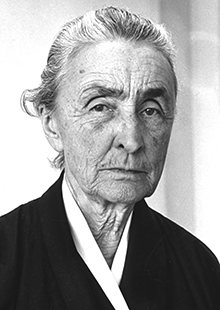 Georgia O'Keeffe: one of a majority of very early morning risers. Photograph: AP
Georgia O'Keeffe: one of a majority of very early morning risers. Photograph: AP
It's not that there aren't successful night owls: Marcel Proust, for one, rose sometime between 3pm and 6pm, immediately smoked opium powders to relieve his asthma, then rang for his coffee and croissant. But very early risers form a clear majority, including everyone from Mozart to Georgia O'Keeffe to Frank Lloyd Wright. (The 18th-century theologian Jonathan Edwards, Currey tells us, went so far as to argue that Jesus had endorsed early rising "by his rising from the grave very early".) For some, waking at 5am or 6am is a necessity, the only way to combine their writing or painting with the demands of a job, raising children, or both. For others, it's a way to avoid interruption: at that hour, as Hemingway wrote, "There is no one to disturb you and it is cool or cold and you come to your work and warm as you write." There's another, surprising argument in favour of rising early, which might persuade sceptics: that early-morning drowsiness might actually be helpful. At one point in his career, the novelist Nicholson Baker took to getting up at 4.30am, and he liked what it did to his brain: "The mind is newly cleansed, but it's also befuddled… I found that I wrote differently then."
Psychologists categorise people by what they call, rather charmingly, "morningness" and "eveningness", but it's not clear that either is objectively superior. There is evidence that morning people are happier and more conscientious, but also that night owls might be more intelligent. If you're determined to join the ranks of the early risers, the crucial trick is to start getting up at the same time daily, but to go to bed only when you're truly tired. You might sacrifice a day or two to exhaustion, but you'll adjust to your new schedule more rapidly.
2. Don't give up the day job
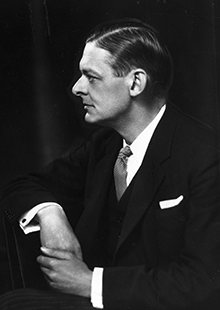 TS Eliot’s day job at Lloyds bank gave him crucial financial security. Photograph: Hulton Archive/Getty Images
TS Eliot’s day job at Lloyds bank gave him crucial financial security. Photograph: Hulton Archive/Getty Images
"Time is short, my strength is limited, the office is a horror, the apartment is noisy," Franz Kafka complained to his fiancee, "and if a pleasant, straightforward life is not possible, then one must try to wriggle through by subtle manoeuvres." He crammed in his writing between 10.30pm and the small hours of the morning. But in truth, a "pleasant, straightforward life" might not have been preferable, artistically speaking: Kafka, who worked in an insurance office, was one of many artists who have thrived on fitting creative activities around the edges of a busy life. William Faulkner wrote As I Lay Dying in the afternoons, before commencing his night shift at a power plant; TS Eliot's day job at Lloyds bank gave him crucial financial security; William Carlos Williams, a paediatrician, scribbled poetry on the backs of his prescription pads. Limited time focuses the mind, and the self-discipline required to show up for a job seeps back into the processes of art. "I find that having a job is one of the best things in the world that could happen to me," wroteWallace Stevens, an insurance executive and poet. "It introduces discipline and regularity into one's life." Indeed, one obvious explanation for the alcoholism that pervades the lives of full-time authors is that it's impossible to focus on writing for more than a few hours a day, and, well, you've got to make those other hours pass somehow.
3. Take lots of walks
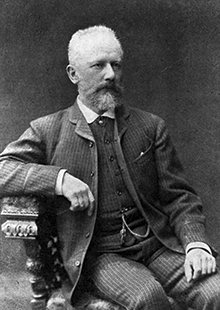 Tchaikovsky 'believed he had to take a walk of exactly two hours a day and that if he returned even a few minutes early, great misfortunes would befall him.' Photograph: Hulton Archive/Getty Images
Tchaikovsky 'believed he had to take a walk of exactly two hours a day and that if he returned even a few minutes early, great misfortunes would befall him.' Photograph: Hulton Archive/Getty Images
There's no shortage of evidence to suggest that walking – especially walking in natural settings, or just lingering amid greenery, even if you don't actually walk much – is associated with increased productivity and proficiency at creative tasks. But Currey was surprised, in researching his book, by the sheer ubiquity of walking, especially in the daily routines of composers, including Beethoven, Mahler, Erik Satie and Tchaikovksy, "who believed he had to take a walk of exactly two hours a day and that if he returned even a few minutes early, great misfortunes would befall him". It's long been observed that doing almost anything other than sitting at a desk can be the best route to novel insights. These days, there's surely an additional factor at play: when you're on a walk, you're physically removed from many of the sources of distraction – televisions, computer screens – that might otherwise interfere with deep thought.
4. Stick to a schedule
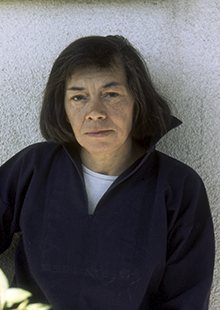 Patricia Highsmith, among others, ate virtually the same thing for every meal, in her case bacon and fried eggs. Photograph: Corbis Sygma
Patricia Highsmith, among others, ate virtually the same thing for every meal, in her case bacon and fried eggs. Photograph: Corbis Sygma
There's not much in common, ritual-wise, between Gustave Flaubert – who woke at 10am daily and then hammered on his ceiling to summon his mother to come and sit on his bed for a chat – and Le Corbusier, up at 6am for his 45 minutes of daily calisthenics. But they each did what they did with iron regularity. "Decide what you want or ought to do with the day," Auden advised, "then always do it at exactly the same moment every day, and passion will give you no trouble." (According to legend, Immanuel Kant's neighbours in Königsberg could set their clocks by his 3.30pm walk.) This kind of existence sounds as if it might require intimidating levels of self-discipline, but on closer inspection it often seems to be a kind of safety net: the alternative to a rigid structure is either no artistic creations, for those with day jobs, or the existential terror of no structure at all.
It was William James, the progenitor of modern psychology, who best articulated the mechanism by which a strict routine might help unleash the imagination. Only by rendering many aspects of daily life automatic and habitual, he argued, could we "free our minds to advance to really interesting fields of action". (James fought a lifelong struggle to inculcate such habits in himself.) Subsequent findings about "cognitive bandwidth" and the limitations of willpower have largely substantiated James's hunch: if you waste resources trying to decide when or where to work, you'll impede your capacity to do the work. Don't consider afresh each morning whether to work on your novel for 45 minutes before the day begins; once you've resolved that that's just what you do, it'll be far more likely to happen. It might have been a similar desire to pare down unnecessary decisions that led Patricia Highsmith, among others, to eat virtually the same thing for every meal, in her case bacon and fried eggs. Although Highsmith also collected live snails and, in later life, promulgated anti-Semitic conspiracy theories, so who knows?
5. Practise strategic substance abuse
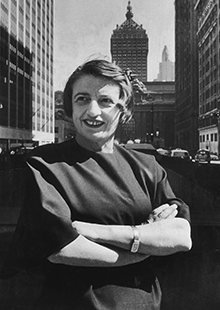 Ayn Rand took Benzedrine. Photograph: New York Times Co/Getty Images
Ayn Rand took Benzedrine. Photograph: New York Times Co/Getty Images
Almost every potential chemical aid to creativity has been tried at some time or another: Auden, Ayn Rand and Graham Greene had their Benzedrine, the mathematician Paul Erdös had his Ritalin (and his Benzedrine); countless others tried vodka, whisky or gin. But there's only one that has been championed near-universally down the centuries: coffee. Beethoven measured out his beans, Kierkegaard poured black coffee over a cup full of sugar, then gulped down the resulting concoction, which had the consistency of mud; Balzac drank 50 cups a day. It's been suggested that the benefits of caffeine, in terms of heightened focus, might be offset by a decrease in proficiency at more imaginative tasks. But if that's true, it's a lesson creative types have been ignoring for ever. Consume in moderation, though: Balzac died of heart failure at 51.
6. Learn to work anywhere
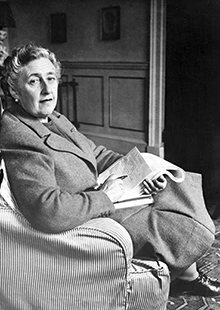 Agatha Christie didn’t have a desk. Any stable tabletop for her typewriter would do. Photograph: AFP/Getty Images
Agatha Christie didn’t have a desk. Any stable tabletop for her typewriter would do. Photograph: AFP/Getty Images
One of the most dangerous procrastination-enabling beliefs is the idea that you must find exactly the right environment before you can get down to work. "For years, I said if only I could find a comfortable chair, I would rival Mozart," the American composer Morton Feldman recalled. Somerset Maugham had to face a blank wall before the words would come (any other view, he felt, was too distracting). But the stern message that emerges from many other artists' and authors' experiences is: get over yourself. During Jane Austen's most productive years, at Chawton in Hampshire in the 1810s, she wrote mainly in the family sitting-room, often with her mother sewing nearby. Continually interrupted by visitors, she wrote on scraps of paper that could easily be hidden away. Agatha Christie, Currey writes, had "endless trouble with journalists, who inevitably wanted to photograph the author at her desk": a problematic request, because she didn't have one. Any stable tabletop for her typewriter would do.
In any case, absolute freedom from distraction may not be as advantageous as it sounds. One study recently suggested that some noise, such as the background buzz of a coffee shop, may be preferable to silence, in terms of creativity; moreover, physical mess may be as beneficial for some people as an impeccably tidy workspace is for others. The journalistRon Rosenbaum cherishes a personal theory of "competing concentration": working with the television on, he says, gives him a background distraction to focus against, keeping his attentional muscles flexed and strong.
But there is a broader lesson here. The perfect workspace isn't what leads to brilliant work, just as no other "perfect" routine or ritual will turn you into an artistic genius. Flaubert didn't achieve what he did because of hot baths, but through immeasurable talent and extremely hard work. Which is unfortunate, because I'm really good at running baths.
Benzedrine, naps, an early night: an extract from Daily Rituals
Gertrude Stein
In Everybody's Autobiography, Stein confirmed that she had never been able to write for much more than half an hour a day, but added, "If you write a half-hour a day, it makes a lot of writing year by year." Stein and her lifelong partner, Alice B Toklas, had lunch at about noon and ate an early, light supper. Toklas went to bed early, but Stein liked to stay up arguing and gossiping with visiting friends. After her guests finally left, Stein would wake Toklas, and they would talk over the day before both going to sleep.
Ludwig van Beethoven
Beethoven rose at dawn and wasted little time getting down to work. His breakfast was coffee, which he prepared himself with great care: 60 beans per cup. After his midday meal, he embarked on a long walk, which would occupy much of the rest of the afternoon. As the day wound down, he might stop at a tavern to read the newspapers. Evenings were often spent with company or at the theatre, although in winter he preferred to stay at home and read. He retired early, going to bed at 10pm at the latest.
WH Auden
"Routine, in an intelligent man, is a sign of ambition," Auden wrote in 1958. If that's true, the poet was one of the most ambitious men of his generation. He rose shortly after 6am, made coffee and settled down to work quickly, perhaps after taking a first pass at the crossword. He usually resumed after lunch and continued into the late afternoon. Cocktail hour began at 6.30pm sharp, featuring several strong vodka martinis. Then dinner was served, with copious amounts of wine. To maintain his energy and concentration, he relied on amphetamines, taking Benzedrine each morning. At night, he used Seconal or another sedative to get to sleep.
Sylvia Plath
Plath's journal, which she kept from age 11 until her suicide at 30, records a near-constant struggle to find and stick to a productive writing schedule. Only near the end of her life, separated from her husband, Ted Hughes, and taking care of their two small children alone, did she find a routine that worked for her. She was using sedatives to get to sleep, and when they wore off at about 5am, she would get up and write until the children awoke. Working like this for two months in 1962, she produced nearly all the poems of Ariel.
Alice Munro
In the 1950s, as a young mother taking care of two small children, Munro wrote in the slivers of time between housekeeping and child-rearing. When neighbours dropped in, Munro didn't feel comfortable telling them she was trying to work. She tried renting an office, but the garrulous landlord interrupted her and she hardly got any writing done. It ultimately took her almost two decades to put together the material for her first collection, Dance Of The Happy Shades.
David Foster Wallace
"I usually go in shifts of three or four hours with either naps or fairly diverting do-something-with-other-people things in the middle," Wallace said in 1996, shortly after the publication of Infinite Jest. "So I'll get up at 11 or noon, work till two or three." Later, however, he said he followed a regular writing routine only when the work was going badly. "Once it starts to go, it requires no effort. And then actually the discipline's required in terms of being willing to be away from it and to remember, 'Oh, I have a relationship that I have to nurture, or I have to grocery-shop or pay these bills.' "
Ingmar Bergman
"Do you know what moviemaking is?" Bergman asked in a 1964 interview. "Eight hours of hard work each day to get three minutes of film." But it was also writing scripts, which he did on the remote island of Fårö, Sweden. He followed the same schedule for decades: up at 8am, writing from 9am until noon, then an austere meal. "He eats the same lunch," actorBibi Andersson remembered. "It's some kind of whipped sour milk and strawberry jam – a strange kind of baby food he eats with corn flakes." After lunch, Bergman worked from 1pm to 3pm, then slept for an hour. In the late afternoon he went for a walk or took the ferry to a neighbouring island to pick up the newspapers and the mail. In the evening he read, saw friends, screened a movie, or watched TV (he was particularly fond of Dallas). "I never use drugs or alcohol," Bergman said. "The most I drink is a glass of wine and that makes me incredibly happy."
Wednesday, 18 September 2013
What is Religion
Part 1: civil religion and the state
The 'God' of American civil religion supplies a way for society to judge itself from a standpoint exterior to power
The recent death of Robert Bellah made me reread his classic essay on American civil religion, which first appeared in 1967 and this, in turn, sparked a series' worth of questions on what religion is. Bellah believed, as I have come to do, that a society without religion is impossible. This claim will strike quite a lot of readers as wholly absurd, as ridiculous as supposing that Earth goes round the sun when any fool can see the sun crossing the heavens several times at least in any English summer. So I think it's worth examining and defending at some length.
The first requirement, if you are going to do this, is to break all notions of religion as being something essentially like Christianity or any of the other monotheisms of today. To talk about "religion" as if the perfect form was modern Christianity is like talking about biology as if the perfect mammal was homo sapiens.
Bellah was a sociologist and to some extent an anthropologist too. He knew very well that there have been innumerable different forms of religion, and that counter-examples can be found for everything that is supposed to be distinctively religious. You don't need priests, holy books, or doctrines. You don't even need myths. All these are things which, once established, are hard to be rid of, because they reflect and help to constitute increasingly complex models of social organisation which will tend to replace more simple ones. But none of them are essential to a religion.
At the same time, it's important not to go too far in the other direction, and to suppose that every social activity, and every movement of the inner life, can be described as in some sense religious.
Bellah himself started off in the 70s with a long and complicated definition and ended up with a very simple and powerful one. This came in part from the early 20th-century philosopher George Santayana, who wrote that having a religion meant having "another world to live in – whether we expect ever to pass wholly over into it or not".
What Bellah added to this was the point that the world of everyday, from which religion promises to deliver us, is not more real, or less constructed than the one we access through religious practices. Everyday life may involve different kinds of cognition, but the world we see through its mechanisms is just as much the product of wish fulfilment as heaven might be. Only the appetites being satisfied in there are different.
And living entirely in the daily life world of those narrow appetites and immediate problems to solve is literally intolerable. No one can manage it all the time. He doesn't mean by this that religion speaks to our higher or more unselfish instincts. It needs to be taken for granted in these arguments that some forms of religion are almost entirely malign and lead to horror. But religion is also, importantly, selfless. Its atrocities derive from a higher cause. They offer the hope that things will be different.
How does this map on to his idea of an American civic religion, distinct from Christianity? Perhaps the most important point of his essay, easily overlooked, is that there has been from the very beginning of the Republic, he says, an American civil irreligion competing with the civil religion as a narrative and a general theory of the state and its people. Again, it is a characteristic of this thought that there are struggles rather than simplicities.
The struggle between civil religion and civil irreligion is also one between republicanism and liberalism as these were understood in the late 18th century. Republicanism, certainly as it was understood in the 18th century, depends utterly on religion, because a republic is built and maintained by its citizens in their interactions with each other. They have to subordinate themselves quite deliberately to a vision of a common good, and they must see this as fulfilling their own natures. That, very simply, is the task of religion. This is the spirit that he sees infuses the Declaration of Independence.
Against this is the competing tradition of liberalism, more fully developed in the constitution. Liberalism (in this sense) has no need of God because it trusts that the self-interest of the citizens will lead them to the best possible outcome: "the state is a purely neutral legal mechanism without purposes or values. Its sole function is to protect the rights of individuals, that is, to protect freedom." Such a state is, he thinks, an absurd impossibility, which could never exist (non-existence does not of course much diminish its power over our imaginations).
States and societies must have a way to judge themselves from some standpoint exterior to power. It is not enough for religion to give us access to another world: we must be able to contemplate our everyday world and judge it by the standards of the one we reach. And this judgment is what the "God" of American civil religion supplies. This God is clearly distinct from the Christian one, and still more the Jewish one. Rather he is the being who rescues, or who might sometimes rescue, America from the evil angels of its nature.
Whatever else you think of his ideas, this task is pressing today.
------
Part 2: why football doesn't measure up
The most blinding and obvious deficiency of football as a religion is that it lacks any kind of theology – and excludes many women

'For a lot of people the fate of their football team does affect them the way that God's good opinion is supposed to do.' Photograph: Carl Recine/Action Images
A perfectly reasonable question to ask of people like me, who define "religion" in a way that plays down theology, is why something like football should not be a religion. After all, it involves collective emotion, quasi-mystical experiences of loss of selfhood in a higher purpose, even if that is only to crush those bastards from the visiting team. IfNick Hornby's Fever Pitch is to be believed, it is also a way of coming to terms with the disappointments and tragedies of life. Going to a match with your estranged father has something of the effect that taking communion together is meant to have for Christians.
If you do a Google news search, in the months of an English winter, for terms like "miracle", or "messiah" many results will turn out to be about football matches. For a lot of people the fate of their football team does affect them the way that God's good opinion is supposed to do. All kinds of mental illness and unhappiness diminish when their team does well, and increase when it does badly. And then there is the Bill Shankly quote, that football isn't a matter of life or death, it's much more important than that: this, in itself, is a wonderful definition of the ambitions of religious truth – that it should be more important than life or death.
And yet football very clearly isn't a proper religion. And the reasons why cast some light on what religions are, or must be.
I should perhaps add here that I am completely unsympathetic to the game. I have only been to one serious football match (a north London derby) in my life, when I was accompanying a police patrol. We sat on the touchline, and came away with our shoulders coated with spittle because the people behind us were howling out their feelings without any inhibitions. I will watch football sometimes on screens because the movement is so completely meaningless. I suppose this is a vague equivalent to the homoerotic pleasures of liturgical traditionalists.
But I absolutely lack something which is obviously a deep part of the engagement of real football fans – the ability to suspend disbelief so that I feel I am in some way present on the pitch myself. The sale of replica shirts that is such an important part of the economics of modern football clearly depends on the idea that you take on some of the virtue of the player whose number you wear. That's clearly one of the mechanisms that makes up religions. But it's not enough on its own.
And this is important. Religions aren't made from specially "religious" behaviour or thoughts, but from ordinary patterns of thought and behaviour which are assembled in particular ways.
The most blinding and obvious deficiency of football as a religion is that it lacks any kind of theology. There is in fact an absurd public rhetoric embraced by Fifa about brotherhood but no one takes it seriously. Although theology is the least important part of any religious system, and the one which alters most in response to changes either in public ritual or in private emotion, it is needed as a way to make sense – to the participants – of what is going on.
I'm inclined to think that it is a further disadvantage that football matches have results. It really doesn't matter what football managers say in public compared to what their players do. Compare this to American civil religion, which could be identified, and analysed by Robert Bellah because he had texts to work with. He was able to point out, and to analyse, the implicit theologies of American public rhetoric, and the kinds of things that presidents said when they wanted to unite their country around a common purpose. If you were to do that to the speeches made by football managers, the results would be less rewarding. The Gettysburg Address was rather more than a half-time pep talk in the American civil war.
But all this is really rather theoretical. The real reason why football could never function as a religion is blindingly obvious – which is why we are blind to it. Many women find it boring and incomprehensible.
For the most part "serious" men's football is an escape from all the problems entailed by the existence of another sex. This has its charms, but it won't do at all for a religion, which has to offer sense and meaning and hope to the whole of life. If religions were only expressions of willed stupidity, willed escapism, and orgies of communal feeling, then, yes, football might be a religion. But since it isn't, there must be more to religions than that.
-----
part 3: the role of the ritual
Robert Bellah argues that religion is underpinned and preceded by ritual – but that does not make all ritual religious

'Acts such as staring at the sunset might be a root of some of our perceptions of the world as ineffable and infinitely valuable.' Photograph: David Bigwood / Alamy
If you treat religion as a natural phenomenon, as Robert Bellah did, two things follow. The first is that what we observe will not have clear or logical boundaries. This means that what constitutes a religion is really quite hard to specify even if it is fairly easy to recognise. The second point is that any of the social phenomena or psychological phenomena we are interested in will have a history. In some aspects this will be an evolutionary history. What we have will have developed from earlier forms, and the capacities we use will have evolved from earlier ones.
This is most obvious in the case of language. It's reasonable to say that there could be no religion without a language – reasonable, but hardly inarguable. A great many of the experiences we think of as quintessentially religious come without language, mystical ones in particular. (I know it is perfectly possible for an atheist to have mystical experiences and to shape their life around them while denying them any theological explanation. So it would clearly be wrong to say that mystical experiences enforce any particular religious position. That's not the point.)
Nonetheless, even wordless religious experiences are embedded in language. Animals without language might have proto-religious experiences, but these are clearly not the same as those which a linguistically competent human has. The primatologist Sue Savage-Rumbaugh once described to me a line of chimpanzees staring in apparent bliss at a sunset – something which might be a root of some of our perceptions of the world as ineffable and infinitely valuable. But the chimpanzees will never tell stories about it, and never try to embed the experience in a web of explicit meanings. Both of those things must form part of any religious experience.
So the emergence of language must have preceded the emergence of religion. Bellah, however, moved towards the view that ritual preceded both, and made both possible. This is a very large claim for ritual. It is made in compressed form in the big bookReligion in Human Evolution, and in an earlier, more spacious way in the paper Durkheim and Ritual, reprinted in the Robert Bellah reader.
Essentially, he argues that shared attention directed through repetitive and stereotyped actions is the essence of ritual, and that it is also at the root of all human learning, including the transactions between a mother and her baby. This makes a lot of sense when you consider the extraordinarily ritualised proto-language that we use when communicating with babies. When practised between two people, ritual and play give rise to love, whether sexual, parental, or simply between friends. When practised in larger groups, ritual and play give us religion and language.
This is a very compressed version of the argument. I have for instance entirely left out his speculations on the importance of music in the process, although they are also relevant to language acquisition, as anyone who talks to toddlers will tell you. But it carries the minimum we need to understand his approach to the question of what religion is.
Talking about the importance of ritual in this way is frequently attacked as a way to defend the relevance of religion in a world where it is (or merely ought to be) irrelevant. It looks like special pleading. Passages such as this: "Since ritual, for Durkheim, is primarily about the sacred in a sense in which the religious and the social are almost interchangeable, subsequent work … might be seen as disclosing an element of the sacred, and thus of the religious, at the very basis of social action of any kind," lend strength to the suspicion that this is just a way to make sociologists look as if they had the key to all mythologies, something no other scientists, of course, would ever do.
But the suspicion is importantly misplaced. To show that the earliest religions arise from the same processes as the ritual capabilities which make us distinctively human, is not an argument that everything which subsequently evolved using those capabilities must be religious.
The sense in which Bellah's claim seems to me really important, as well as quite right, is that it undercuts the idea that there is a special "religious" mode of irrationality – a mind virus, if you will – that could be eradicated and leave the rest of our humanity intact and purified. On the contrary, if you could remove the roots of religion, you remove the roots of humanity, too. Ritual and narrative are the basic ways by which we learn what it is to be human, and I don't think it's grotesque imperialism to regard arguments about which rituals and narratives are truly religious ones – whether or not their conclusions are atheistic.
-----
part 4: divinity, God and 'real' religion
Can you have a religion not based around the Abrahamic idea of a God who could, if he wished, behave like a mafia boss?
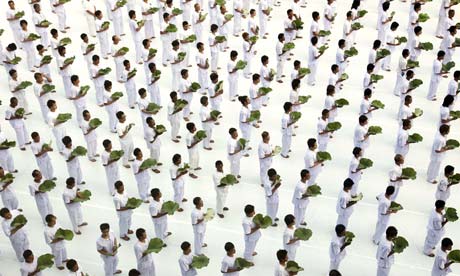
Thai men take part in a mass meditation ceremony. Photograph: Sipa Press/Rex Features
One of the most unnerving passages in Robert Bellah's Religion in Human Evolution is the section where he examines the central Jewish and Christian idea of a covenant with God. He traces it back to the treaties imposed by the remarkably brutal Assyrian empire on the nations it subjugated.
Some of the treaties have been preserved, so that it is possible to compare the language with that of the Bible. It turns out that the language in which God addresses Israel is almost identical to the language with which the Assyrians address the rulers they have suffered to remain in the states they would otherwise devastate. The nearest modern analogy would perhaps be for some tiny Baltic state like Estonia to model its understanding of God on Stalin. In both cases, there is a fundamental asymmetry of power: the weaker party is bound and compelled to obedience and even to love. The stronger party is entirely untrammelled.
"In both Assyrian and Israelite versions of the vassal covenant the subordinate must keep the stipulations of the treaty or face the most disastrous consequences: in Israel God, in Assyria the gods, will inflict leprosy, blindness, violent death, rape, and invasion by 'a nation you have not known' if the subordinate is disloyal."
Two questions arise from this. The first is whether this isn't just a really powerful argument for atheism – it looks as if the central idea of God's chosen people has nothing to do with revelation and is more a kind of wish-fulfilment arising from an abusive relationship. There is a counter-argument sketched out in Bellah's book, which I don't want to go into here because to enter into it would move away from the central question of what a religion is.
That demands that we ask the second question – whether there could be religions that were not based around the Abrahamic idea of a God who could, if he wished, behave like a mafia boss: the being Blake called "Old Nobodaddy".
I am writing this at a meeting of the British Society for the Philosophy of Religion, which has been discussing atheisms. The plural is important, because one of the arguments here is that both religion and atheism are socially constituted. If you complicate the definition of religion, you also constitute the definitions of atheism, yet both complications are forced on us by the variety and inventiveness of human societies.
It is almost universally true that what counts as religion in one society at one time will be atheistic in another, and vice versa. Both Socrates and the early Christians were persecuted as atheists, yet its obvious that both lived in a world filled with spirits. Equally, most people are atheists with regard to most gods.
Even strict naturalists will claim to have transcendent experiences. Some will claim this with peculiar fervour, as if they wanted to show that atheists lost nothing by abandoning God. So it's perfectly possible, even if uncommon, to be a strict naturalist and Buddhist (I think Susan Blackmore would qualify as an example) and, clearly, Buddhism is generally classed as a religion.
So let's sharpen the question to whether it is possible to have a conception of the divine that does not involve any kind of personal God, or God having any kind of personal relationship with the believer.
Such a set of beliefs would be largely inarticulate. There might be a kind of intellectual superstructure – as there is in Buddhism – but a worked-out theology would be unnecessary especially if the main structure of religious participation was built around rituals and practices rather than creeds. In some forms of eastern religion, the only words required of a believer are mantras that are quite deliberately meaningless, or rapidly become so with repetition.
This does seem to me to be an almost entirely depersonalised picture of something otherworldly, whether we call it the divine, the transcendent, or the ultimately real. Whatever it is called it triumphantly fulfils Bellah's criterion that religion should show us another world and allow us to criticise and better understand this one from the other's perspective.
Of course, much of Buddhism isn't like this. You might argue that the deracinated Buddhism of western intellectuals isn't a real religion just as some antitheists argue that the beliefs of philosophically sophisticated Christian theologians aren't "real" Christianity. But I don't think this argument holds for a religion like Buddhism, which has no founding covenant. It can't be wrong to defy the intentions of a non-existent God. But it can be a very religious act.
-----
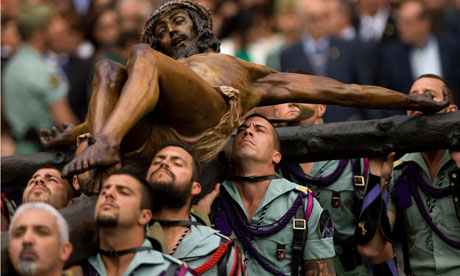
-----
How are religions born?
What is religion, part 5: In the systems we know about, either folk beliefs coalesce or a charismatic founder emerges

Spanish soldiers in Malaga carry a statue of Christ during a holy week procession. Photograph: Jorge Guerrero/AFP/Getty Images
Since they are historical entities, religions are born and die. I'll think about their death some other time. But how do they emerge, and from what? This isn't a question with a single answer, although there are a couple of popular stories about the process left over from the 19th century.
It's widely believed, for example, either that religions must have a charismatic founder, a prophet figure, or that they are more or less self-conscious frauds perpetrated by a priestly class against the common people. This second version is clearly a secularised version of the Protestant history of the Reformation, and makes very little sense as a general theory. Obviously there have been examples of both types of religion formation. It's possible that Mormonism combines both, since a charismatic founder managed to create a social structure with huge rewards for the priesthood. But there are too many exceptions for these rules to be generally valid.
Robert Bellah's account of the emergence of religion might be said to break off just at the point when it becomes easy to talk about the emergence and existence of particular religions, distinguished clearly from other forms of social activity. The very earliest religions are, in Bellah's telling, indistinguishable from culture. He follows Emile Durkheim and most anthropologists in seeing "religion" as an intensification of ritual first of all. The things that everyone in the tribe does together, and the stories they tell together become their religion – or at least what anthropologists could study and classify as religion.
It's not at all clear that the people studied by anthropologists would understand this distinction. They certainly don't understand it theologically. There is a good attack on these kinds of misunderstandings in Pascal Boyer's book The Naturalness of Religious Ideas, in which he points out that most anthropological accounts of "primitive beliefs" refer to something that does not actually exist: "They [are not] thoughts that occur to actual people; they describe thoughts that people might entertain, in the anthropologist's view, if they wanted to make sense of what they actually do and say."
Bellah, with his stress on ritual and on the embodiment of beliefs in wider systems of meaning, avoids this pitfall. You make sense of what you do and say by acting on it, and embodying it in a larger narrative, not by extracting it into a system.
Yet systems do emerge, and they form a large part of what we now think of as religion. Although some form of healing ritual, and healing specialist, seems to have been among the very earliest precursors of religion, and of priesthood, the emergence of any kind of "religion" organisationally distinct from the rest of culture depends at the very least on agriculture, which provides enough of a surplus in fixed settlements.
It seems certain that religions, like other social forms, evolve: that is to say they arise from modifications of earlier forms. The trouble for historical inquiry is simply that without written records we simply have to guess what happened. With written records, we need no longer guess, but can be authoritatively misled. Two excellent accounts of this process are Tom Holland's book In the Shadow of the Sword, about the invention of Islam, and Jim Macdonald's blogpost on the emergence of the Bible as fan fiction.
In those religious systems we know about, there seem to be two processes under way. The first is a kind of coalescence of folk beliefs and practices into something more or less organised and more or less useful to the state. Shinto looks like that, and Hinduism. You could make a case that American Protestantism, which has increasingly less to do with historic, Orthodox Christianity, is heading in the other direction.
Then there are the religions that can be traced back to a single charismatic founder – most obviously Christianity and Islam, but also Sikhism and Mormonism, to name two modern successes.
In all these cases, there is considerable doubt about the relation of the teacher to the teaching subsequently encoded in their name (as with Marx and Marxism), but it does seem that the idea of the perfect teacher helps to spread teachings. The best illustration of that is Judaism, which seems to have been a coalescence or codification – with considerable distortions – of a folk religion recollected in exile, but which was codified around the almost entirely invented figure of Moses.
It seems intuitively obvious that in the modern world, where people must make a self-conscious choice of religion or belief system, a charismatic founder figure who can say "follow me" is necessary. But like many things intuitively obvious, this is wrong. Even today, the most interesting religious movements are those that coalesce without a single founder or a body of organised doctrine – Rastafarianism is a small example, charismatic Christianity a much more important one. There are still religions being born that will change the world.
Subscribe to:
Comments (Atom)

